
Pasiphila plinthina is a moth in the family Geometridae. It is endemic to New Zealand and is found in both the North, South and Stewart Islands. It is on the wing mainly from June until September with occasional observations up to December, and is attracted to light. This species is similar in appearance to P. sandycias but can be distinguished from it as P. plinthina has palpi that are longer and has more blurred forewing markings.
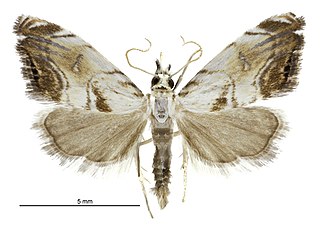
Glaucocharis harmonica is a moth in the family Crambidae. This species was described by Edward Meyrick in 1888. It is endemic to New Zealand and is found in the North and South Islands. It inhabits lowland to subalpine native forest. It has been hypothesised that there are two broods per year. The larval hosts are unknown. Adults are on the wing from October until January.

Pyrgotis eudorana is a species of moth of the family Tortricidae. It is endemic in New Zealand and has been observed in both the North and South Islands. However it is regarded as a rare insect. This species inhabits native forest. Larvae exclusively feed on Muehlenbeckia australis and adults are on the wing from November to April. Adults are attracted to light.
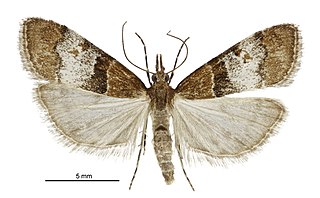
Antiscopa acompa is a moth in the family Crambidae. It was first described by Edward Meyrick in 1884. It is endemic to New Zealand and is found both the North and South Islands. The species inhabits native forest and adult moths are attracted to light.

Asaphodes albalineata is a species of moth in the family Geometridae. It is endemic to New Zealand and has been observed on Stewart Island / Rakiura. This species is similar in appearance to Asaphodes oraria but can be distinguished as it has an unusual pattern on the underside of its hindwings. It inhabits open hill tops and adults are on the wing in December.
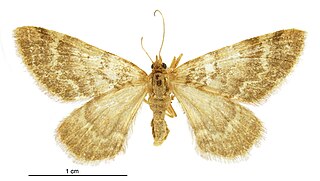
Asaphodes aphelias is a species of moth in the family Geometridae. It is endemic to New Zealand and has been observed in Fiordland. This species inhabits damp native scrub and has been observed in upland wetlands at altitudes of between 800 and 1100 m. Adults are on the wing in February but the female of this species is unusual as it has narrow fore and hind wings.
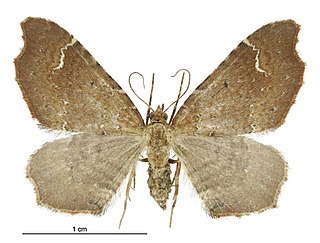
Asaphodes camelias is a species of moth in the family Geometridae. It is endemic to New Zealand, has been observed in both the North and South Islands and inhabits native forest. The adults of this species are on the wing from February to May and July to September.

Asaphodes cosmodora is a species of moth in the family Geometridae. This species is endemic to New Zealand and has been observed in the South Island. The adults of this species are on the wing in January and February.
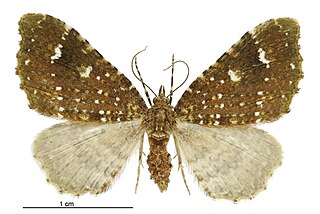
Asaphodes limonodes is a species of moth in the family Geometridae. It is endemic to New Zealand and is found in both the North and South Islands. This species inhabits damp native forest. Adults are on the wing from November until March.

Mallobathra metrosema is a moth of the family Psychidae.This species was first described by Edward Meyrick in 1888. It is endemic to New Zealand and has been observed in the North and South Islands. This species is known to inhabit remnant floodplain native forest. Adults have been seen on the wing in September and January. This species is regarded as being uncommon in the Low Canterbury Plains Ecological District.
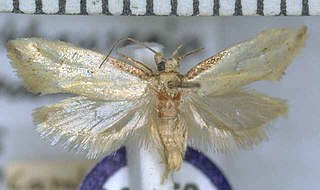
Tingena apanthes is a species of moth in the family Oecophoridae. It is endemic to New Zealand and found on the North Island. The adults are on the wing from October to December. It appears associated with Leptospermum species and it has been hypothesised that the appearance of the adults of this species imitates faded Leptospermum leaves.
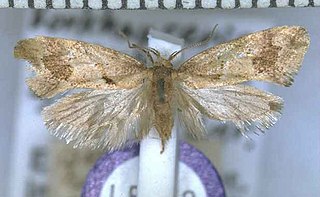
Tingena penthalea is a species of moth in the family Oecophoridae. It is endemic to New Zealand and has been observed in Wellington and the Tararua Range. The adults of this species are on the wing from December until February.

Tingena pronephela is a species of moth in the family Oecophoridae. It is endemic to New Zealand and is found in the southern parts of the South Island. The species inhabits the outskirts of scrub and native forest. The adults of this species are on the wing from October to February.

Asaphodes nephelias is a moth in the family Geometridae. It is endemic to New Zealand and has been observed in the South Island. The preferred habitat of this species is alpine tussock grasslands above native forest and in wetlands. The adults of this species are on the wing from January to March and are day flying. The female has brachypterous wings.

Asaphodes omichlias is a moth in the family Geometridae. It is endemic to New Zealand and has been observed in both the North and South Islands. This species inhabits rocky, open country in high mountains. Adults are on the wing in January and February. The appearance of the adult of this species is variable with some specimens having a paler and more grey appearance than the more usual brown appearance. Its colouration ensures it blends well with its preferred habitat rocky, open country in the high mountains.

Asaphodes prasinias is a moth in the family Geometridae. It is endemic to New Zealand and has been found on both the North and South Islands. This species inhabits native forest including beech forest and subalpine scrub. The range of this species has reduced as this species is regarded as being locally extinct in the previously inhabited open non-forest habitats around Invercargill. Adults are on the wing from November to January.

Asaphodes prymnaea is a moth in the family Geometridae. It is endemic to New Zealand and can be found on the Mount Arthur tableland. It is common in limestone valleys. The female of the species is paler and has less distinctive markings than the male. Adults are on the wing in January and February.

Asaphodes sericodes is a moth in the family Geometridae. It is endemic to New Zealand and has been observed in the southern parts of the South Island. This species inhabits open tussock grasslands in subalpine scrub or wetlands. The female of the species is likely semi-apterous and is flightless. The adult males are on the wing in January.
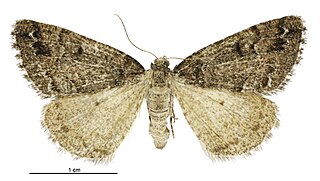
Pseudocoremia colpogramma is a species of moth in the family Geometridae. This species was described by Edward Meyrick in 1936. It is endemic to New Zealand.

Trachypepla lichenodes is a moth of the family Oecophoridae first described by Edward Meyrick in 1883. It is endemic to New Zealand and has been found in both the North and South Islands. It inhabits native forest and adults of this species are on the wing from November to January. The adult moths are similarly coloured to native lichen species however this colouration is variable in the extent and depth on the forewings.























